Effects of Adding Neutralized Red Mud on the Hydration Properties of Cement Paste
Abstract
:1. Introduction
2. Experimental Program
2.1. Materials
2.2. Experimental Plan
2.3. Methods
3. Results and Discussion
3.1. Heat of Hydration
3.2. Compressive Strength
3.3. Microstructure
4. Conclusions
- (1)
- The heat of hydration measurement results indicated that the maximum heat of hydration peak exhibited a low calorific value and was delayed for the cement paste with LRM in comparison with Plain. Conversely, the heat of hydration peak of the cement paste containing LRM + S was found to be similar to that of Plain.
- (2)
- The compressive strength at the age of 28 d for the cement paste with LRM was found to be as low as 55% of the compressive strength of Plain, whereas the cement paste with LRM + S showed a strength ratio as high as 99%.
- (3)
- In the XRD analysis, the cement paste with 20% LRM + S, unlike in the case of LRM sample, showed a Ca(OH)2 peak after only 1 h, similar to the case of Plain. In addition, no new products due to the addition of red mud were observed.
- (4)
- As the compressive strength of LRM + S10 at 28 d was similar to that of Plain, it can be assumed that (under the same conditions as in this study) up to 10% neutralized red mud can be added to cement pastes without affecting its strength.
Author Contributions
Funding
Conflicts of Interest
References
- Ribeiro, D.V.; Labrincha, J.A.; Morelli, M.R. Potential use of natural red mud as pozzolan for Portland cement. Mater. Res. 2011, 14, 60–66. [Google Scholar] [CrossRef]
- Li, J.; Xu, L.; Sun, P.; Zhai, P.; Chen, X.; Zhang, H.; Zhang, Z.-S.; Zhu, W. Novel application of red mud: Facile hydrothermal-thermal conversion synthesis of hierarchical porous AlOOH and Al2O3 microspheres as adsorbents for dye removal. Chem. Eng. J. 2017, 321, 622–634. [Google Scholar] [CrossRef]
- Yang, J.; Xiao, B. Development of unsintered construction materials from red mud wastes produced in the sintering alumina process. Constr. Build. Mater. 2008, 22, 2299–2307. [Google Scholar] [CrossRef]
- Nath, H.; Sahoo, A. A study on the characterization of red mud. Int. J. Appl. Bioeng. 2014, 8, 1–4. [Google Scholar] [CrossRef] [Green Version]
- Dodoo-Arhin, D.; Nuamah, R.A.; Agyei-Tuffour, B.; Obada, D.O.; Yaya, A. Awaso bauxite red mud-cement based composites: Characterisation for pavement applications. Case Stud. Constr. Mater. 2017, 7, 45–55. [Google Scholar] [CrossRef]
- Amritphale, S.; Anshul, A.; Chandra, N.; Ramakrishnan, N. A novel process for making radiopaque materials using bauxite—Red mud. J. Eur. Ceram. Soc. 2007, 27, 1945–1951. [Google Scholar] [CrossRef]
- He, J.; Jie, Y.; Zhang, J.; Yu, Y.; Zhang, G. Synthesis and characterization of red mud and rice husk ash-based geopolymer composites. Cem. Concr. Compos. 2013, 37, 108–118. [Google Scholar] [CrossRef]
- Enforcement Regulations of Waste Management Act. Available online: http://www.law.go.kr/%EB%B2%95%EB%A0%B9/%ED%8F%90%EA%B8%B0%EB%AC%BC%EA%B4%80%EB%A6%AC%EB%B2%95%EC%8B%9C%ED%96%89%EA%B7%9C%EC%B9%99 (accessed on 16 September 2020).
- Ribeiro, D.V.; Labrincha, J.A.; Morelli, M.R. Use of red mud as addition for portland cement mortars. J. Mater. Sci. Eng. 2010, 4, 1–8. [Google Scholar]
- Liu, X.; Zhang, N.; Sun, H.; Zhang, J.; Li, L. Structural investigation relating to the cementitious activity of bauxite residue—Red mud. Cem. Concr. Res. 2011, 41, 847–853. [Google Scholar] [CrossRef]
- Choe, G.; Kang, S.; Kang, H. Mechanical Properties of Concrete Containing Liquefied Red Mud Subjected to Uniaxial Compression Loads. Materials 2020, 13, 854. [Google Scholar] [CrossRef] [Green Version]
- Li, Z.; Afshinnia, K.; Rangaraju, P.R. Effect of alkali content of cement on properties of high performance cementitious mortar. Constr. Build. Mater. 2016, 102, 631–639. [Google Scholar] [CrossRef]
- Choe, G.; Kang, S.; Kang, H. Characterization of Slag Cement Mortar Containing Nonthermally Treated Dried Red Mud. Appl. Sci. 2019, 9, 2510. [Google Scholar] [CrossRef] [Green Version]
- Hu, X.; Shi, C.; Shi, Z.; Tong, B.; Wang, D. Early age shrinkage and heat of hydration of cement-fly ash-slag ternary blends. Constr. Build. Mater. 2017, 153, 857–865. [Google Scholar] [CrossRef]
- Wang, Y.; He, F.; Wang, J.; Hu, Q. Comparison of Effects of Sodium Bicarbonate and Sodium Carbonate on the Hydration and Properties of Portland Cement Paste. Materials 2019, 12, 1033. [Google Scholar] [CrossRef] [Green Version]
- Saraya, M.E. Stopping of cement hydration by various methods. HBRC J. 2010, 6, 36–60. [Google Scholar]
- Kim, H.Y. Urea additives for reduction of hydration heat in cement composites. Constr. Build. Mater. 2017, 156, 790–798. [Google Scholar] [CrossRef]
- Kunther, W.; Lothenbach, B.; Scrivener, K. Influence of bicarbonate ions on the deterioration of mortar bars in sulfate solutions. Cem. Concr. Res. 2013, 44, 77–86. [Google Scholar] [CrossRef]
- Kerui, Y.; Caiwen, Z.; Zhigang, L. The influence of calcium lignosulphonate–sodium bicarbonate on the status of ettringite crystallization in fly ash cement paste. Cem. Concr. Res. 2002, 32, 51–56. [Google Scholar] [CrossRef]
- Ortega, J.; Cabeza, M.; Tenza-Abril, A.J.; Real, T.; Climent, M.Á.; Sánchez, I. Effects of Red Mud Addition in the Microstructure, Durability and Mechanical Performance of Cement Mortars. Appl. Sci. 2019, 9, 984. [Google Scholar] [CrossRef] [Green Version]
- Senff, L.; Modolo, R.; Silva, A.S.; Ferreira, V.; Hotza, D.; Labrincha, J.A. Influence of red mud addition on rheological behavior and hardened properties of mortars. Constr. Build. Mater. 2014, 65, 84–91. [Google Scholar] [CrossRef]
- Liu, R.-X.; Poon, C.-S. Utilization of red mud derived from bauxite in self-compacting concrete. J. Clean. Prod. 2016, 112, 384–391. [Google Scholar] [CrossRef]
- He, Y.; Zhang, X.; Liu, S.; Hooton, R.; Ji, T.; Kong, Y. Impacts of sulphates on rheological property and hydration performance of cement paste in the function of polycarboxylate superplasticizer. Constr. Build. Mater. 2020, 256, 119428. [Google Scholar] [CrossRef]
- Sutar, H.; Murmu, R.; Roy, D.; Mishra, S.C. Effect of Red Mud (RM) Reinforcement on Physio-Chemical Characteristics of Ordinary Portland Slag Cement (OPSC) Mortar. Adv. Mater. Phys. Chem. 2016, 6, 231–238. [Google Scholar] [CrossRef] [Green Version]
- Niu, M.; Li, G.; Zhang, J.; Cao, L. Preparation of alkali-free liquid accelerator based on aluminum sulfate and its accelerating mechanism on the hydration of cement pastes. Constr. Build. Mater. 2020, 253, 119246. [Google Scholar] [CrossRef]
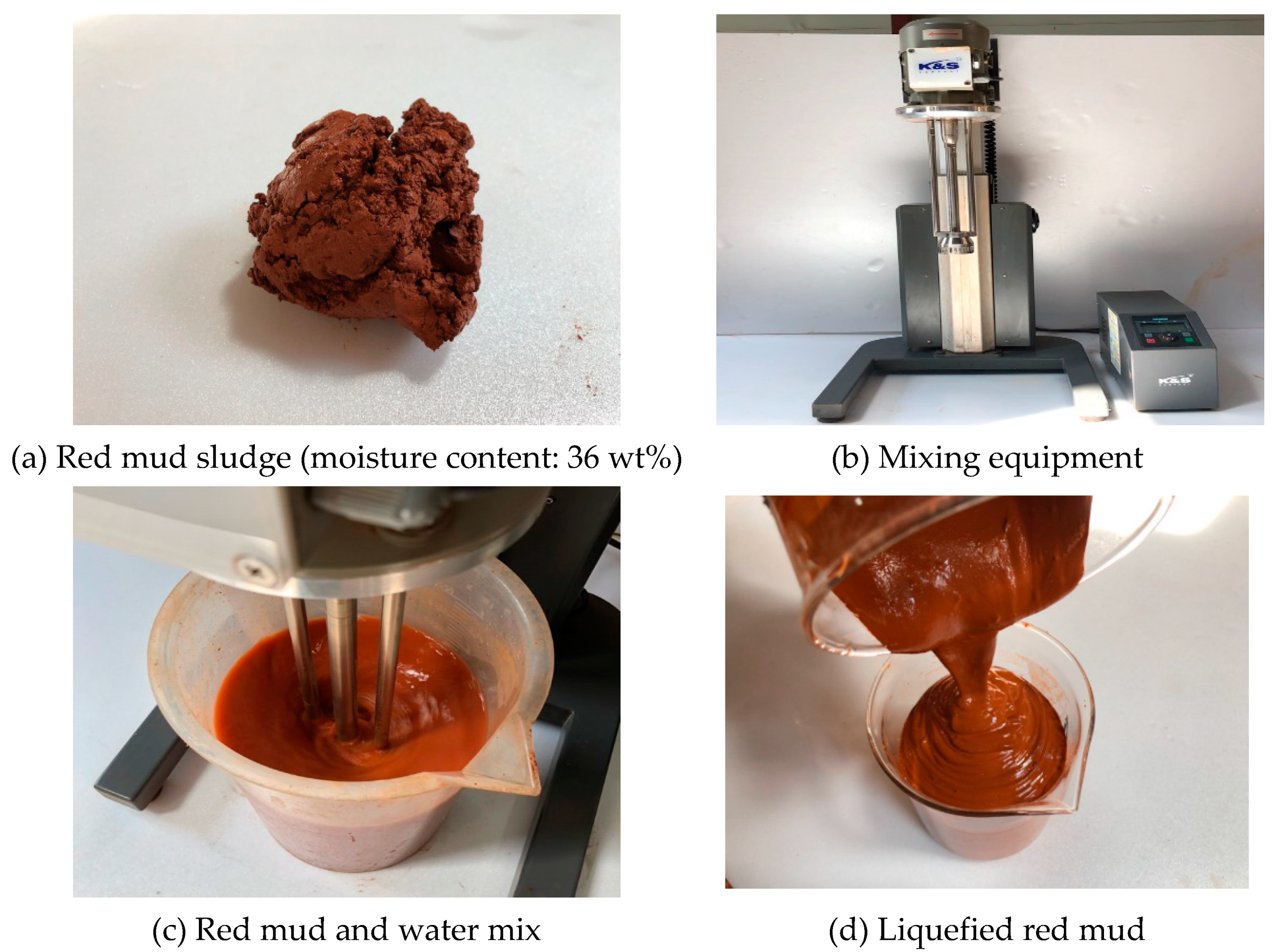

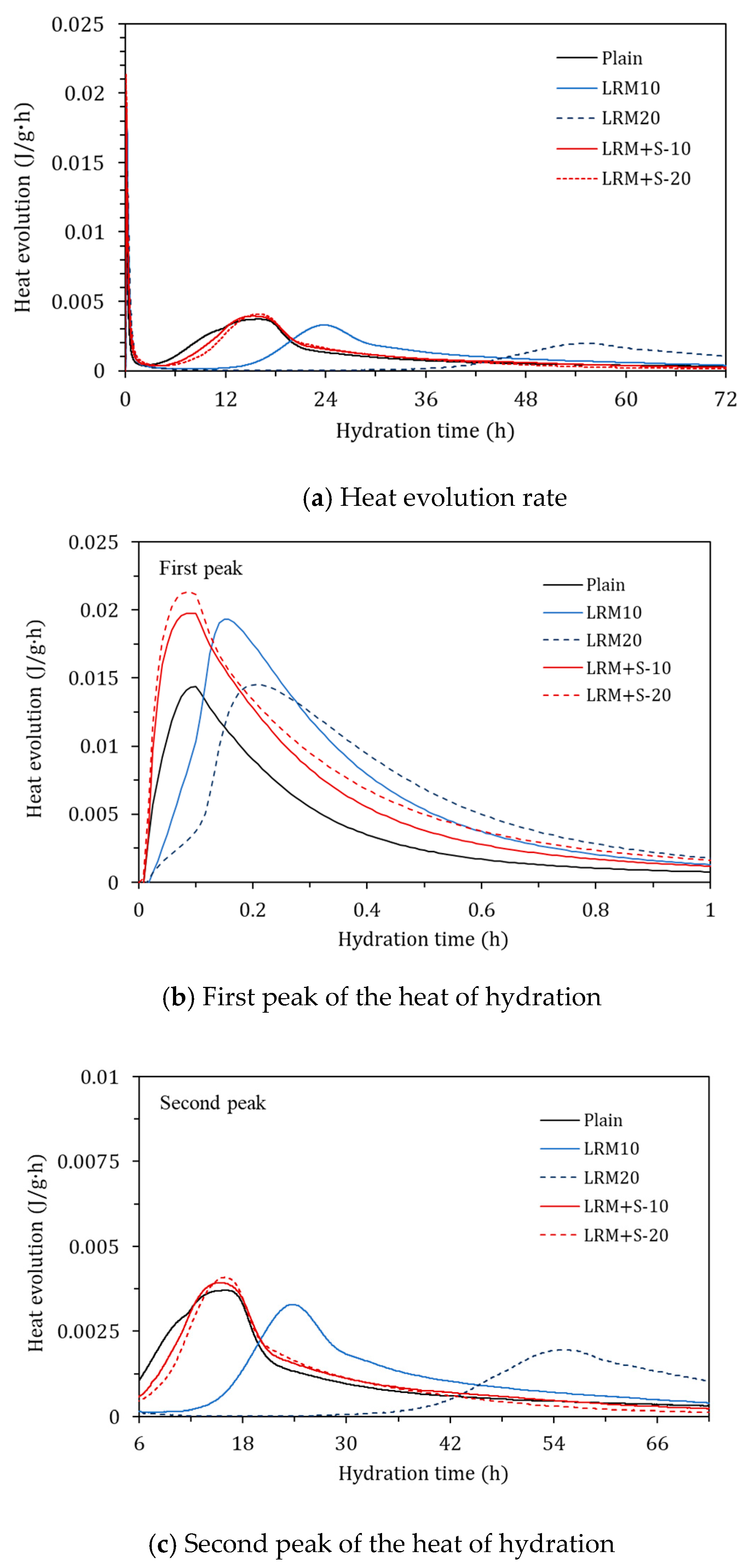
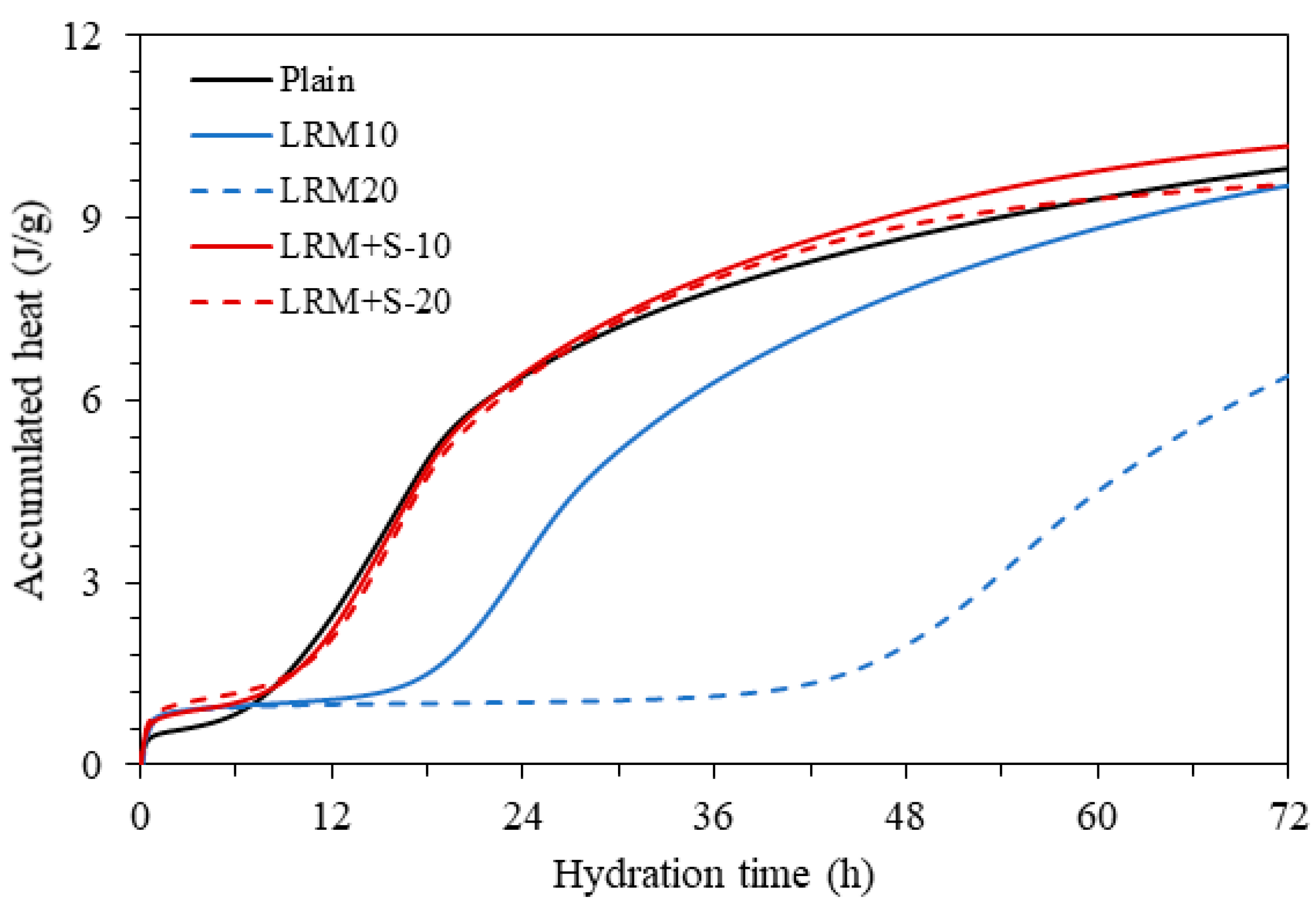
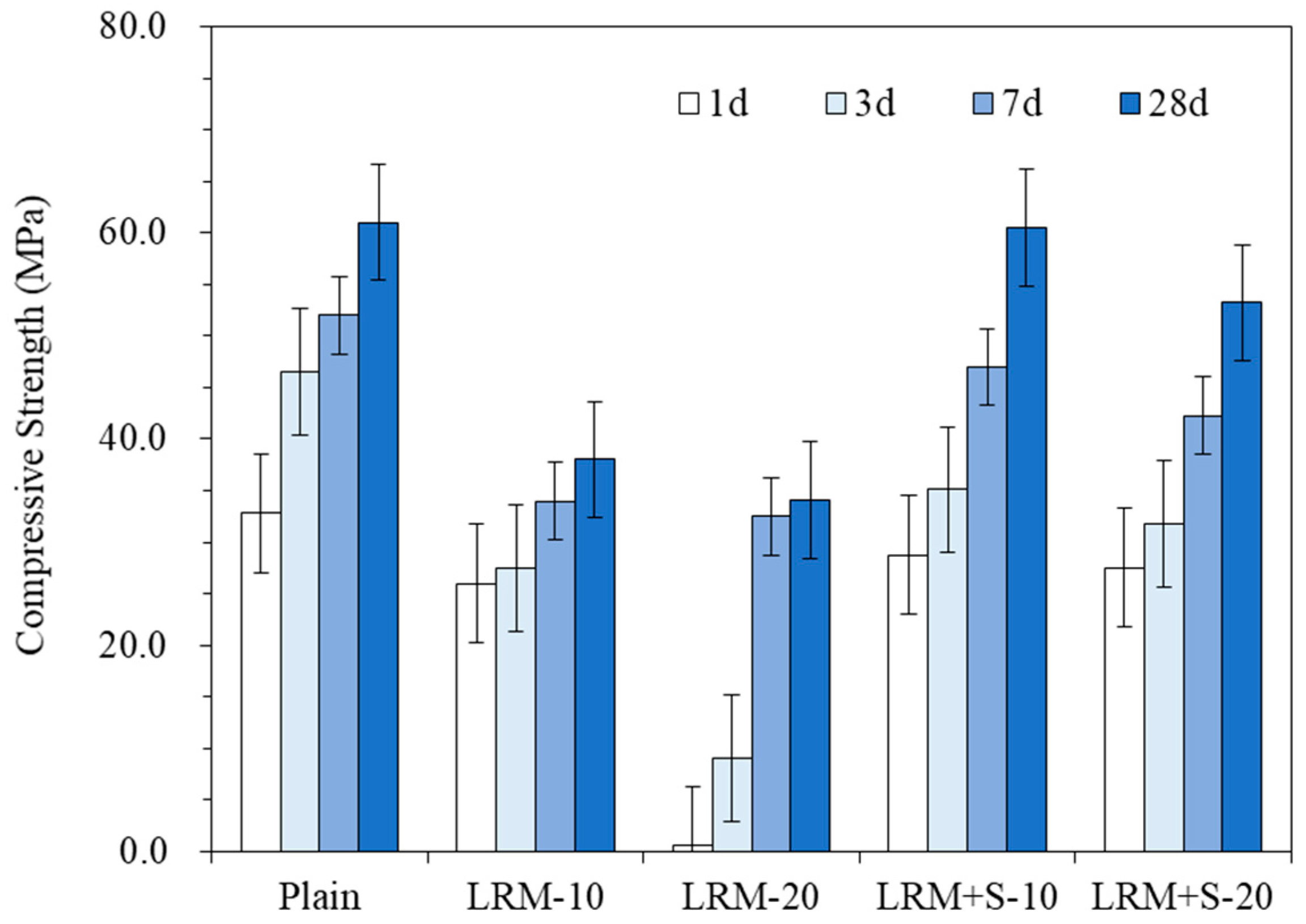
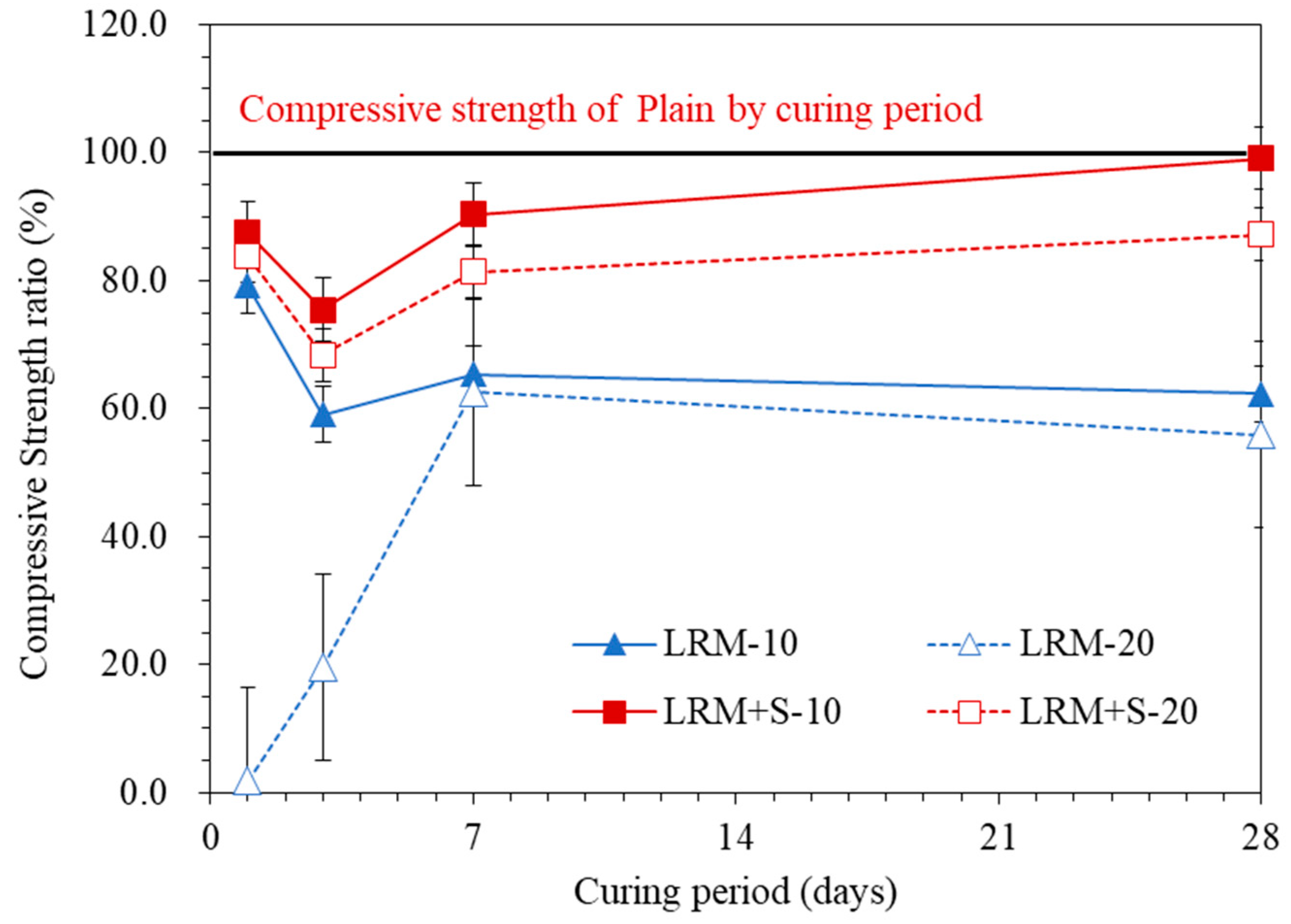
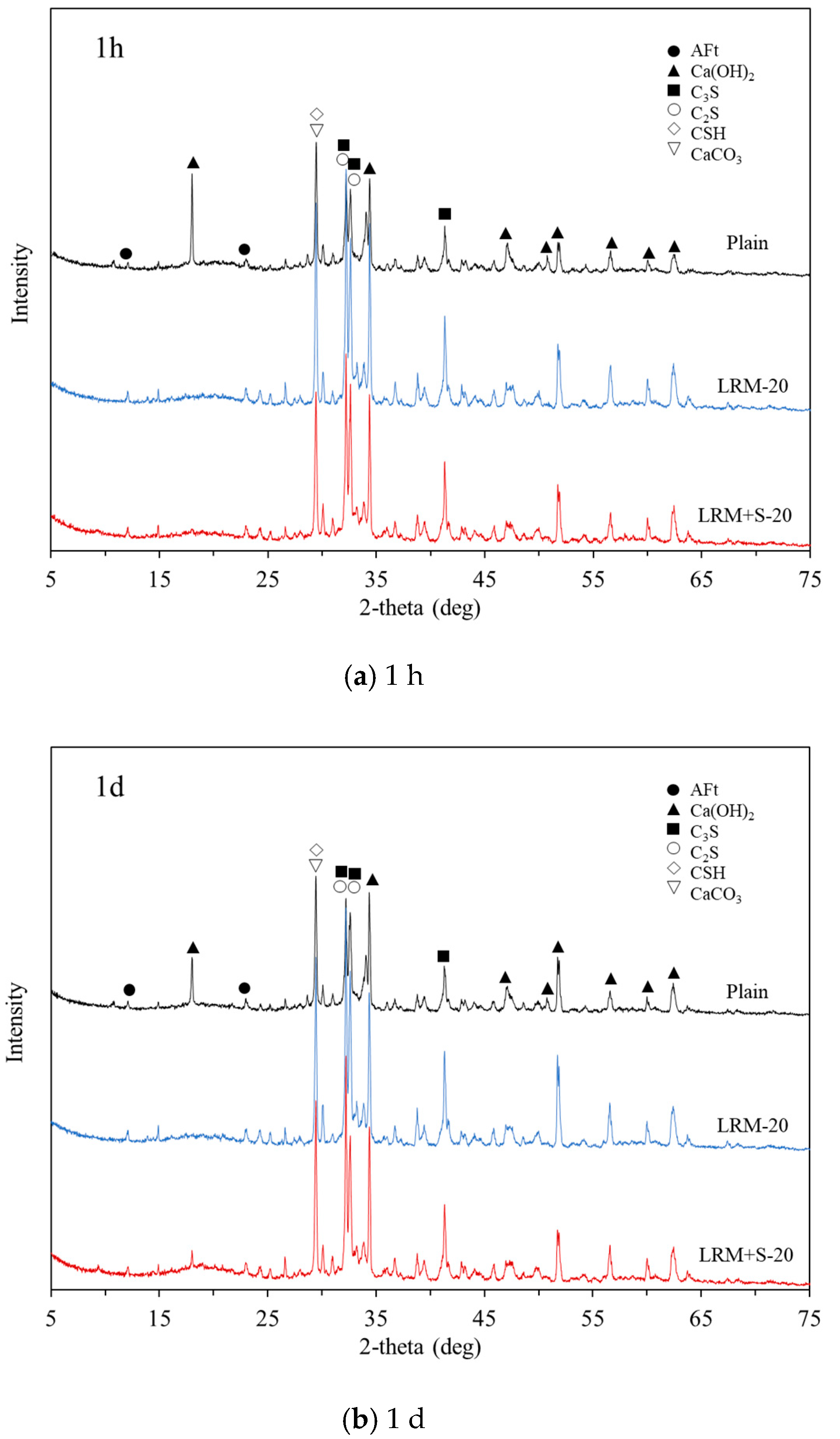
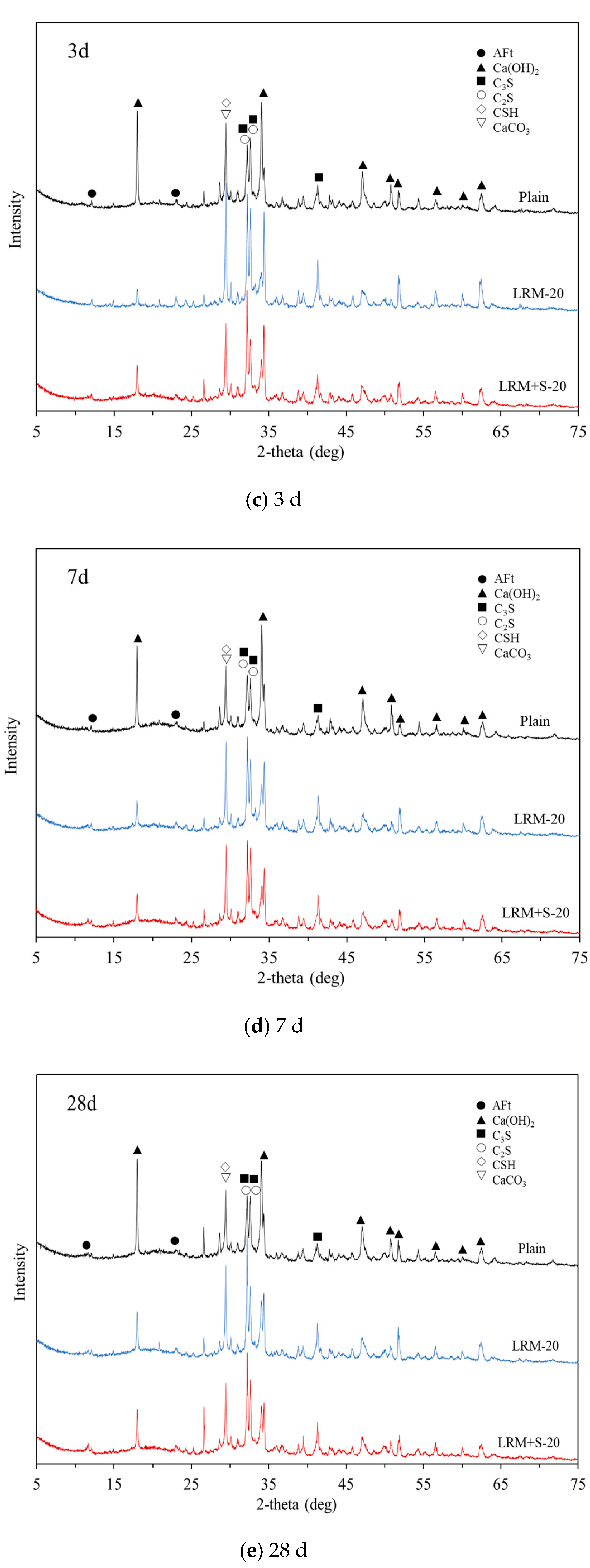
| Type of Red Mud | Moisture Content (%) | pH | Density (g/cm3) | Specific Surface Area (cm2/g) | Average Particle Diameter (μm) | Viscosity (cP) |
|---|---|---|---|---|---|---|
| LRM * | 49.5 | 11.5 | 1.5 | 2353 | 2.75 | 42,550 |
| LRM + S ** | 49.2 | 6.7 | 1.54 | 2353 | 2.75 | 45,250 |
| Type of Red Mud | SiO2 | A12O3 | Fe2O3 | MgO | Na2O | CaO | TiO2 | SO3 |
|---|---|---|---|---|---|---|---|---|
| LRM | 17.6 | 25.6 | 30.4 | 0.21 | 13.2 | 1.83 | 6.27 | 0.29 |
| LRM + S | 17 | 25.4 | 29.2 | 0.21 | 10.7 | 1.84 | 5.99 | 4.48 |
| Type | Blaine (cm2/g) | Setting Time | Density (g/cm3) | Chemical Composition (%) | |||||||
|---|---|---|---|---|---|---|---|---|---|---|---|
| Initial (min) | Final (min) | SiO2 | Al2O3 | Fe2O3 | CaO | MgO | SO3 | lg. Loss | |||
| OPC * | 3300 | 200 | 330 | 3.15 | 21.7 | 5.7 | 3.2 | 63.1 | 2.8 | 2.2 | 2.44 |
| Mix ID | Cement (wt%) | Water (wt%) | Extra Discount Red Mud (wt%) | |
|---|---|---|---|---|
| LRM | LRM + S | |||
| Plain | 100 | 30 | - | - |
| LRM-10 | 10 | - | ||
| LRM-20 | 20 | - | ||
| LRM + S-10 | - | 10 | ||
| LRM + S-20 | - | 20 | ||
© 2020 by the authors. Licensee MDPI, Basel, Switzerland. This article is an open access article distributed under the terms and conditions of the Creative Commons Attribution (CC BY) license (http://creativecommons.org/licenses/by/4.0/).
Share and Cite
Kang, S.; Kang, H.; Lee, B. Effects of Adding Neutralized Red Mud on the Hydration Properties of Cement Paste. Materials 2020, 13, 4107. https://doi.org/10.3390/ma13184107
Kang S, Kang H, Lee B. Effects of Adding Neutralized Red Mud on the Hydration Properties of Cement Paste. Materials. 2020; 13(18):4107. https://doi.org/10.3390/ma13184107
Chicago/Turabian StyleKang, Sukpyo, Hyeju Kang, and Byoungky Lee. 2020. "Effects of Adding Neutralized Red Mud on the Hydration Properties of Cement Paste" Materials 13, no. 18: 4107. https://doi.org/10.3390/ma13184107
APA StyleKang, S., Kang, H., & Lee, B. (2020). Effects of Adding Neutralized Red Mud on the Hydration Properties of Cement Paste. Materials, 13(18), 4107. https://doi.org/10.3390/ma13184107





